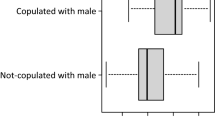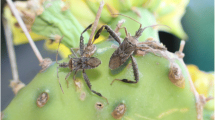Abstract
Both resource-holding potential (RHP) and experience in aggressive contests are known to affect future aggressive behaviour. However, few studies have examined the effects of mating experience on agonistic behaviour, despite the fact that dominant males usually acquire more matings. We investigated the effect of mating experience on male aggressive behaviour including the relationship between RHP and fighting success in the fall field cricket, Gryllus pennsylvanicus. We formed pairs of size- and age-matched males that varied in RHP (relative weapon size) and conducted two experiments. In the first, we varied male mating experience by allowing one male in a pair to either be (a) ‘mated’: court, be mounted and copulate with a virgin female or (b) ‘experienced’: court, be mounted, but prevented from copulating. The second experiment varied postcopulatory experience where the male was allowed (‘contact’) or prevented from (‘no-contact’) continued contact with his recent mate. Following treatment, experimental males engaged in an aggressive contest with the naïve size- and age-matched male. In our first experiment, we found that mated and experienced males were equally likely to escalate contests to combat with a naïve opponent, but mated males were less likely than experienced males to win. There was no effect of mating on the relationship between RHP and fighting success. In our second experiment, we found no effect of maintaining contact with the female on the tendency to escalate or the probability of winning. As in the first experiment, males with relatively larger heads again won more fights and this relationship was unaffected by male experience. These results suggest that mating is itself detrimental to male success in aggressive contests, but that this effect is not sufficient to eliminate the effect of RHP on fighting success.




Similar content being viewed by others
References
Alexander RD (1961) Aggressiveness, territoriality, and sexual behavior in field crickets (Orthoptera: Gryllidae). Behaviour 17:130–223
Andersson M (1994) Sexual selection. Princeton University Press, Princeton
Arlington LC (1929) Cricket culture in China. China J 10:135–142
Arnott G, Elwood RW (2008) Information gathering and decision making about resource value in animal contests. Anim Behav 76:529–542
Brown WD, Smith AT, Moskalik B, Gabriel J (2006) Aggressive contests in house crickets: size, motivation and the information content of aggressive songs. Anim Behav 72:225–233
Brown WD, Chimenti AJ, Siebert JR (2007) The payoff of fighting in house crickets: motivational asymmetry increases male aggression and mating success. Ethology 113:457–465
Bussière LF, Hunt J, Jennions MD, Brooks R (2006) Sexual conflict and cryptic female choice in the black field cricket, Teleogryllus commodus. Evolution 60:792–800
Cade W (1979) The evolution of alternative male reproductive strategies in field crickets. In: Blum MS, Blum NA (eds) Sexual selection and reproductive competition in insects. Academic, New York, pp 343–379
Cornwallis CK, Uller T (2010) Towards an evolutionary ecology of sexual traits. Trends Ecol Evol 25:145–152
Darwin C (1871) The descent of man and selection in relation to sex. Murray, London
Enquist M, Leimar O (1987) Evolution of fighting behaviour: effect of variation in resource value. J Theor Biol 127:187–205
Fischer GJ (1997) Abstention from sex and other pre-game rituals used by college male varsity athletes. J Sport Behav 20:176–184
Grafen A (1987) The logic of divisively asymmetric contests: respect for ownership and the desperado effect. Anim Behav 35:462–467
Hack MA (1997a) Assessment strategies in the contests of male crickets, Acheta domesticus (L.). Anim Behav 53:733–747
Hack MA (1997b) The energetic costs of fighting in the house cricket, Acheta domesticus L. Behav Ecol 8:28–36
Hofmann HA, Schildberger K (2001) Assessment of strength and willingness to fight during aggressive encounters in crickets. Anim Behav 62:337–348
Hofmann HA, Stevenson PA (2000) Flight restores fight in crickets. Nature 403:613
Hood GM (2009) PopTools version 3.1.1. Available on the internet. URL http://www.cse.csiro.au/poptools
Hsu Y-C (1928–1929) Crickets in China. Peking Soc Nat Hist Bull 3:5–41
Hsu YY, Earley RL, Wolf LL (2006) Modulation of aggressive behaviour by fighting experience: mechanisms and contest outcomes. Biol Rev 81:33–74
Huntingford FA, Turner AK (1987) Animal conflict. Chapman and Hall, London
Judge KA (2010) Female social experience affects the shape of sexual selection on males. Evol Ecol Res 12:389–402
Judge KA, Bonanno VL (2008) Male weaponry in a fighting cricket. PLoS ONE 3:e3980
Kelly CD (2008a) The interrelationships between resource-holding potential, resource-value and reproductive success in territorial males: how much variation can we explain? Behav Ecol Sociobiol 62:855–871
Kelly CD (2008b) Why do male tree weta aggressively evict females from galleries after mating? Ethology 114:203–208
Kemp DJ (2006) Ageing, reproductive value, and the evolution of lifetime fighting behaviour. Biol J Linn Soc 88:565–578
Khazraïe K, Campan M (1999) The role of prior agonistic experience in dominance relationships in male crickets Gryllus bimaculatus (Orthoptera: Gryllidae). Behav Process 44:341–348
Killian KA, Allen JR (2008) Mating resets male cricket aggression. J Insect Behav 21:535–548
Kortet R, Hedrick A (2005) The scent of dominance: female field crickets use odour to predict the outcome of male competition. Behav Ecol Sociobiol 59:77–83
Le Boeuf BJ, Peterson RS (1969) Social status and mating activity in elephant seals. Science 163:91–93
Loher W, Dambach M (1989) Reproductive behavior. In: Huber F, Moore TE, Loher W (eds) Cricket behavior and neurobiology. Cornell University Press, Ithaca, pp 1–42
Loher W, Rence B (1978) Mating behavior of Teleogryllus commodus (Walker) and its central and peripheral control. Z Tierpsychol 46:225–259
Maynard Smith J, Price GR (1973) Logic of animal conflict. Nature 246:15–18
McGlone S, Shrier I (2000) Does sex the night before competition decrease performance? Clin J Sport Med 10:233–234
Parker GA (1974) Assessment strategy and the evolution of fighting behaviour. J Theor Biol 47:223–243
Rantala MJ, Kortet R (2004) Male dominance and immunocompetence in a field cricket. Behav Ecol 15:187–191
Shackleton MA, Jennions MD, Hunt J (2005) Fighting success and attractiveness as predictors of male mating success in the black field cricket, Teleogryllus commodus: the effectiveness of no-choice tests. Behav Ecol Sociobiol 58:1–8
Simmons LW (1986) Inter-male competition and mating success in the field cricket, Gryllus bimaculatus (De Geer). Anim Behav 34:567–579
Simmons LW (1988) The contribution of multiple mating and spermatophore consumption to the lifetime reproductive success of female field crickets (Gryllus bimaculatus). Ecol Entomol 13:57–69
Souroukis K, Cade WH (1993) Reproductive competition and selection on male traits at varying sex-ratios in the field cricket, Gryllus pennsylvanicus. Behaviour 126:45–62
Suga Y (2006) Chinese cricket-fighting. Int J Asian Stud 3:77–93
Tachon G, Murray A-M, Gray DA, Cade WH (1999) Agonistic displays and the benefits of fighting in the field cricket, Gryllus bimaculatus. J Insect Behav 12:533–543
Thomas ML, Simmons LW (2010) Cuticular hydrocarbons influence female attractiveness to males in the Australian field cricket, Teleogryllus oceanicus. J Evol Biol 23:707–714
Tregenza T, Wedell N (1997) Definitive evidence for cuticular pheromones in a cricket. Anim Behav 54:979–984
Vahed K (1998) The function of nuptial feeding in insects: a review of empirical studies. Biol Rev 73:43–78
Wagner WE Jr (2005) Male field crickets that provide reproductive benefits to females incur higher costs. Ecol Entomol 30:350–357
Wagner WE Jr, Kelley RJ, Tucker KR, Harper CJ (2001) Females receive a life-span benefit from male ejaculates in a field cricket. Evolution 55:994–1001
Wynn H, Vahed K (2004) Male Gryllus bimaculatus guard females to delay them from mating with rival males and obtain repeated copulations. J Insect Behav 17:53–66
Zuk M (1987) The effects of gregarine parasites, body size, and time of day on spermatophore production and sexual selection in field crickets. Behav Ecol Sociobiol 21:65–72
Zuk M, Simmons LW (1997) Reproductive strategies of the crickets (Orthoptera: Gryllidae). In: Choe JC, Crespi BJ (eds) The evolution of mating systems in insects and arachnids. Cambridge University Press, Cambridge, pp 89–109
Acknowledgements
We thank Darryl Gwynne, Murray McConnell, Chris Reaume, and two anonymous referees for helpful comments on earlier drafts. We acknowledge funding from the Natural Sciences and Engineering Research Council of Canada (NSERC) for a Post-Graduate Scholarship to KAJ and an NSERC Discovery Grant to Darryl Gwynne.
Author information
Authors and Affiliations
Corresponding author
Additional information
Communicated by M. Siva-Jothy
Kevin A. Judge and Janice J. Ting contributed equally to this work.
Rights and permissions
About this article
Cite this article
Judge, K.A., Ting, J.J., Schneider, J. et al. A lover, not a fighter: mating causes male crickets to lose fights. Behav Ecol Sociobiol 64, 1971–1979 (2010). https://doi.org/10.1007/s00265-010-1008-y
Received:
Revised:
Accepted:
Published:
Issue Date:
DOI: https://doi.org/10.1007/s00265-010-1008-y




